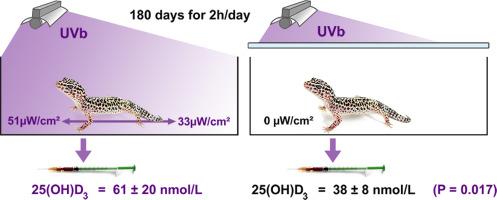Comparative Biochemistry and Physiology B: Biochemistry & Molecular Biology ( IF 2.2 ) Pub Date : 2020-09-17 , DOI: 10.1016/j.cbpb.2020.110506 D G A B Oonincx 1 , J J E Diehl 2 , M Kik 3 , F M Baines 4 , A C Heijboer 5 , W H Hendriks 2 , G Bosch 2

|
Vitamin D is an important regulator of calcium and phosphorus homeostasis in animals. It can be acquired from the diet or synthesised de novo when skin is exposed to UVb. Vitamin D deficiency can lead to a complex of diseases collectively called metabolic bone disease (MBD). Diurnal lizards without access to UVb are prone to develop vitamin D deficiency, even when dietary vitamin D3 is provided. A trial was conducted to determine whether juvenile nocturnal lizards require access to UVb to prevent vitamin D deficiency. All leopard geckos (Eublepharis macularius) were supplemented with dietary vitamin D3. One group was exposed to low level UVb radiation (33–51 μW/cm2) from hatching until 6 months of age and a second group remained unexposed. Animals were fed ad libitum and their growth and weight gain compared with non-exposed controls. At the end of the trial, blood samples were analysed for vitamin D3 metabolites. The concentration of the vitamin D3 metabolite, 25(OH)D3, was higher in UVb exposed animals (61 ± 20 vs. 38 ± 8 nmol/L), confirming cutaneous synthesis with UVb exposure. Growth and weight gain were similar in both groups, and this, together with the absence of clinical symptoms, suggests that dietary vitamin D3 alone can meet the vitamin D requirements for growth of this nocturnal gecko, during the first six months of life. It remains to be investigated whether the higher vitamin D metabolite levels holds other health benefits for this species, such as improved bone density or immune response.
中文翻译:

夜间豹纹壁虎(Eublepharis macularius)使用UVb辐射合成维生素D3。
维生素D是动物体内钙和磷稳态的重要调节剂。当皮肤暴露于紫外线时,可以从饮食中获得或从头合成。维生素D缺乏会导致多种疾病,统称为代谢性骨病(MBD)。即使提供饮食中的维生素D 3,没有UVb的昼夜蜥蜴也容易出现维生素D缺乏症。进行了一项试验,以确定少年夜间蜥蜴是否需要使用UVb来预防维生素D缺乏症。所有豹纹壁虎(Eublepharis macularius)都补充了饮食中的维生素D 3。一组暴露于低水平的UVb辐射(33–51μW/ cm 2),直到孵化至6个月大为止,第二组仍未暴露。随意喂养动物,与未暴露的对照组相比,它们的生长和体重增加。在试验结束时,分析了血液样本中的维生素D 3代谢产物。暴露于UVb的动物体内维生素D 3代谢产物25(OH)D 3的浓度更高(61±20 vs. 38±8 nmol / L),证实了暴露于UVb的皮肤合成。两组的生长和体重增加相似,并且没有临床症状,这表明饮食中的维生素D 3在生命的头六个月内,仅此一项就可以满足夜间壁虎生长所需的维生素D。较高的维生素D代谢物水平是否对该物种具有其他健康益处,例如改善的骨密度或免疫反应,还有待研究。



























 京公网安备 11010802027423号
京公网安备 11010802027423号